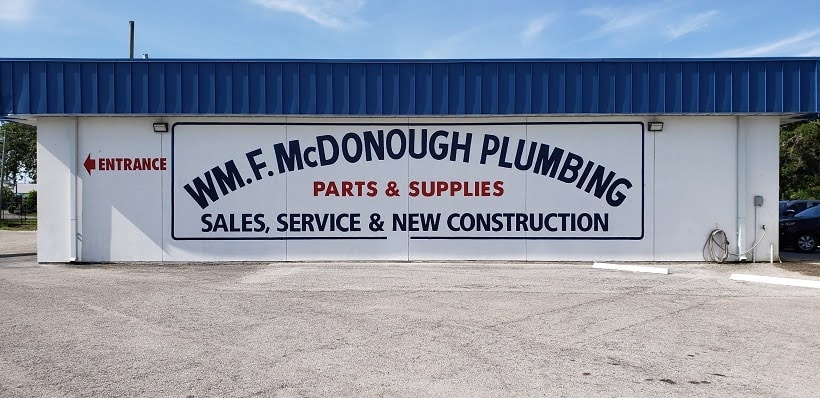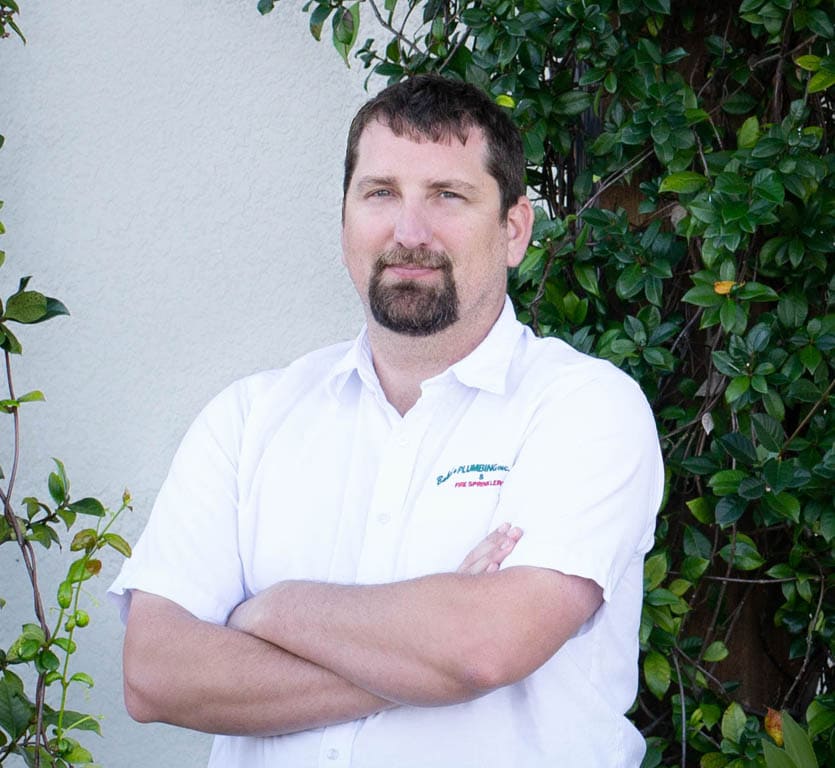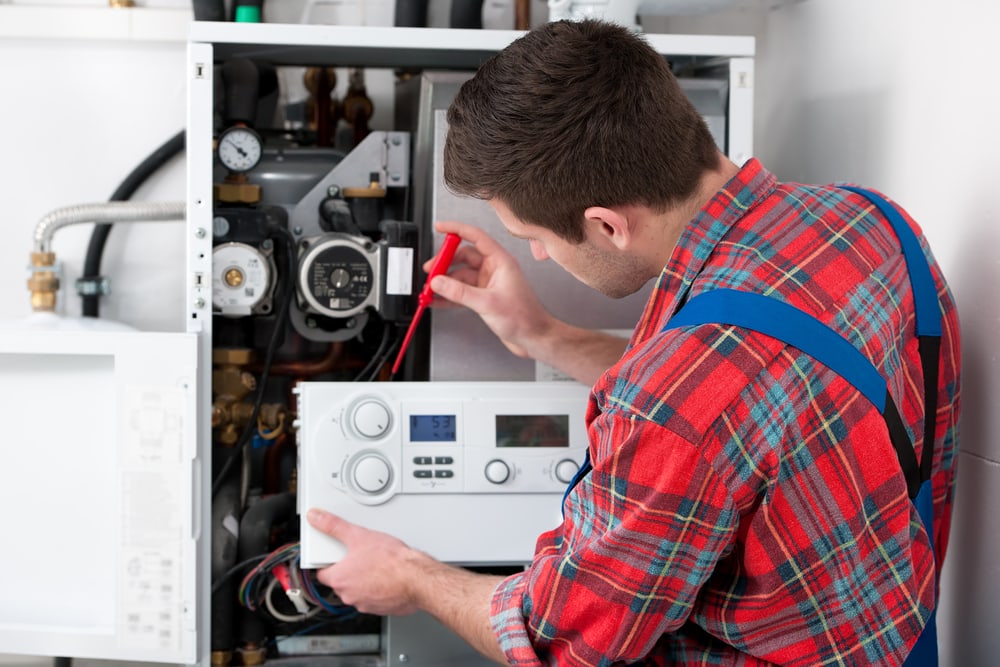
Wm F. McDonough Plumbing of Port Charlotte acquired by Babe’s Plumbing, Inc.
July 28, 2022
Understanding Kitchen Faucets: How to Fix a Faucet That Won’t Turn Off
September 6, 2023Knowing how to repair a gas water heater can feel like a daunting task.
It’s one of those household chores that seems so complex it makes even the handiest homeowner shudder. But here’s the thing…
Even the most skilled homeowner need not be intimidated, as with a bit of knowledge and the right tools, they can easily take on this task. With some rudimentary know-how and the correct apparatus, you can take on this task with aplomb.
This guide will walk you through easy steps to repair a gas water heater at home – safely and efficiently. Let’s turn that apprehension into accomplishment!
Table of Contents:
- Identify the Problem
- Shut Off Gas Supply
- Disconnect Gas Line
- Inspecting Your Gas Line: A Vital Step in Water Heater Repairs
- Reconnect Gas Line
- Turn On Natural Gas Supply Again
- Turn On Gas Supply
- Testing Your Gas Water Heater Post-Repair
- FAQs in Relation to How to Repair Gas Water Heater
- Conclusion
Identify the Problem
The first step in resolving any issues with your gas water heater is identifying the problem. This means inspecting for visible signs of damage or leaks on your unit.
A common issue that homeowners often encounter is a leaking hot water heater, which could be due to various reasons such as a faulty relief valve, corrosion within the tank, or an improperly sealed drain valve. A clear indication would be pooling water around your hot water tank.
Understanding Your Gas Water Heater’s Functionality
To effectively diagnose problems with your gas water heater and ensure its proper operation post-repair work, it’s beneficial to understand how this appliance works. Key components include the burner assembly where natural gas ignites, providing heat; control valves managing flow rate and temperature inside; pilot flame lighting up main burners when needed; thermocouple acting as a safety device shutting off the supply if the pilot light goes out.
If you notice insufficient hot water coming from taps, this might indicate potential issues with heating elements inside electric units or a dip tube diverting cold incoming water down while allowing heated water to rise upwards for use within the system. The absence of warm liquid may suggest a malfunctioning thermostat controlling desired temperatures in the storage area.
Detecting Potential Gas Leaks
In some cases, a smell near the appliance can signal possible leaks from connecting pipelines supplying the fuel source towards the unit itself, like an attached line carrying propane into the combustion chamber.
Babes Plumbing offers a comprehensive range of services covering routine maintenance checks along with regular repair jobs involving complex tasks related to replacing worn-out parts, ensuring optimum performance levels are maintained consistently throughout the operational lifespan.
Key Takeaway: Repairing a gas water heater involves identifying the problem, understanding its functionality, and detecting potential gas leaks. Common issues include leaks due to faulty valves or corrosion, insufficient hot water indicating problems with heating elements or dip tubes, and smells suggesting gas leaks. Knowledge of your unit’s operation is crucial for effective diagnosis and repair.
Shut Off Gas Supply
In the process of water heater repairs, safety is paramount. This begins with turning off your gas supply to the hot water tank.
If you’re unsure how a gas water heater works or where to locate its control valve, consider seeking assistance from an experienced plumber like Babes Plumbing. Remember that handling natural gas improperly can lead to serious consequences.
Finding The Control Valve
The location of this critical component varies across different models and brands of propane or natural gas water heaters. However, it’s usually on an external pipe connected directly to your unit.
This knob typically features three settings: “On”, “Off”, and “Pilot”. To ensure no more fuel flows into your burner assembly during maintenance work, turn this knob counterclockwise until it aligns with the ‘Off’ setting.
Safety Precautions When Shutting Off Your Gas Water Heater
- No Smoking: Always refrain from smoking when working near potential sources of leaking gases, as they are highly combustible.
- Ventilation Matters: It’s crucial for areas around any type of heating element, such as those inside a hot water check system, to be well-ventilated while undergoing repair work.
- Gloves & Safety Glasses Are Essential: Wearing gloves and safety glasses can help prevent accidental burns or eye injuries caused by high-temperature components within a hot-water system.
Contacting A Professional If Necessary
If there’s still a lingering smell after shutting down the main burner flame and pilot light, despite having turned off their respective valves, don’t hesitate to contact professionals immediately. They have specialized equipment designed for detecting leaks safely while providing a prompt response to mitigate possible hazards of escaping gases from faulty appliances, including heaters.
Key Takeaway:
Before diving into gas water heater repairs, safety is key. Always turn off the gas supply first and know where to find the control valve. Remember: no smoking, ensure good ventilation, and wear protective gear. If in doubt or if a gas smell persists after shutting down your system – call in the pros.
Disconnect Gas Line
The gas line disconnection is a vital step in repairing your water heater. The safety and precision involved cannot be overstated.
If you detect any smell of natural gas before or during this procedure, evacuate immediately and contact your local gas utility company.
Safety Measures to Consider
Your personal safety should always come first when dealing with tasks like this. This includes wearing protective gear such as gloves and eyewear to shield against potential leaks or hot water splashes.
A well-ventilated area around the water heater is also necessary to prevent harmful gases from accumulating while performing these operations on propane gas water heaters.
Finding and Turning Off the Gas Valve
To begin the disconnection process, locate the control valve – usually found where the main burner assembly meets it. Turn off the knob completely by rotating counterclockwise until it rests at the ‘off’ position. This effectively stops the flow of natural gas into the appliance itself.
Dismantling the Connection Between the Water Heater and the Main Supply Source
With no more fuel coming through now that we’ve turned off the device’s supply source (the “main”), use an adjustable wrench to remove the connection between the pipe leading directly to the unit. Be careful not to damage the threads; they are important parts that help keep everything securely fastened inside the system’s structure.
Inspecting Your Gas Line: A Vital Step in Water Heater Repairs
Inspecting your gas line may appear to be complex, but it’s really a simple job that can be divided into achievable parts. Let’s walk through the essential actions to take when examining your gas water heater’s lifeline.
1. Spotting Visible Damage
Your first step is conducting a visual check for signs of damage on the surface of the gas line or at its connection points with vital components like the control valve and burner assembly. This includes looking out for cracks, holes, corrosion – anything that could potentially cause leaks affecting both efficiency and safety.
If you spot any wear and tear indicating replacement may be necessary, don’t hesitate to contact professionals who are experts in hot water tank systems powered by natural gas or propane.
2. Evaluating Corrosion Levels
Beyond visible damages lies another potential problem – corrosion caused by exposure over time due to moisture presence around pipes carrying cold water supply towards heating elements inside these appliances responsible for maintaining desired temperature levels within homes across Venice, FL & Boca Grande areas alike.
Key Takeaway: Regular inspection of your gas water heater’s line is crucial for its efficiency and safety. Look out for visible damage, evaluate corrosion levels, and use a soapy solution to detect leaks. If you spot any issues or if the task seems overwhelming, don’t hesitate to call in professionals specializing in hot water tank systems powered by natural gas or
Reconnect Gas Line
The reconnection of the gas line to your water heater is a crucial step in its repair. This process requires careful execution, as an improper connection can lead to dangerous situations like gas leaks.
Safety Precautions are Paramount
Prioritizing safety before starting this task is essential. Wearing protective gear such as gloves and eye protection ensures personal safety while working with the natural gas line. It is also crucial to ensure no open flames or sparks near your work area.
Proper Alignment of Gas Line
To begin reconnecting the gas line, align it correctly with the inlet on your propane or electric water heater unit. The gas pipe should fit snugly into place without requiring excessive force that could potentially damage either component.
Note:
If at any point during this procedure, you smell natural gas or suspect a leak may be present, immediately contact professional help from companies dealing with these kinds of emergencies. Remember: Safety first.
Turn On Natural Gas Supply Again
Your final step in restoring the hot water supply involves turning on the natural gas supply. This will ensure the smooth operation of your water heater.
Turn On Gas Supply
The task is to restore the gas supply to your water heater. This step, while seemingly simple, holds immense importance in ensuring that your hot water tank resumes its function safely and effectively.
Prioritizing Safety
Before you proceed with turning on the gas supply for your propane gas water heater or natural gas variant alike, it’s essential that all other appliances are switched off. Avoid smoking or using any open flame near this area, as these gases can be highly combustible. If there’s a smell of leaking gas before or after initiating the process, don’t hesitate to reach out immediately to professionals like Babes Plumbing serving Venice, FL and Boca Grande areas.
Taking Action: Turning On The Gas Supply
To start with, this procedure involves locating the control valve, which should ideally be positioned close to your heating unit – usually marked distinctively via a red knob acting as an interface between the inflow of natural propane into the system from the main burner assembly through its corresponding control valve.
Gently rotate this knob counterclockwise until the “on” position aligns perfectly without forcing against resistance; if such a situation arises, do not force-turn but rather seek professional help right away.
Vital Checks Post Procedure: Checking For Leaks
A significant part of restoring functionality includes performing checks for potential leaks once the flow has been resumed towards the main burner assembly via the respective control valves within the setup.
- You could use either leak detector device available commercially;
- If unavailable, then homemade solutions also work just fine, e.g., a soapy solution applied around joints/connections, including those involved in the cold-water intake and hot-water output channels associated directly with the unit under consideration here today.
Key Takeaway:
When restoring the gas supply to your water heater, safety is paramount. Ensure all appliances are off and avoid open flames. Locate the control valve near your unit and gently turn it on; if you meet resistance, call a professional. Lastly, check for leaks using commercial or homemade solutions.
Testing Your Gas Water Heater Post-Repair
Testing your newly repaired gas water heater is the final step to ensure everything works as expected.
In essence, this test confirms that both heating elements are working correctly and that there aren’t any lingering issues with other components, such as the control valve or burner assembly.
A Thorough Hot Water Check Is Essential
To conduct an effective hot water check, turn on a faucet in your home and let the cold water inside the tank heat up by running for several minutes. If you consistently get hot water from this faucet, then congratulations. The repair was successful.
- If the hot water is not consistent, additional steps may be necessary.
- You should also inspect whether adjustments made via the temperature control accurately reflect in the output water.
Detecting Leaks And Ensuring Safety Measures Are In Place
Your pressure relief valve plays an important role in preventing excessive pressure build-up within the tank. Therefore, checking its functionality post-repair is essential.
FAQs in Relation to How to Repair Gas Water Heater
What is the most common problem with a gas water heater?
The most frequent issue with gas water heaters is typically insufficient hot water, often caused by thermostat issues or sediment build-up in the tank.
Can you repair a gas water heater?
Yes, many problems with a gas water heater can be repaired. However, if it’s an older unit or has significant damage, replacement might be more cost-effective.
What causes a gas water heater to stop working?
A variety of factors could cause your gas water heater to stop functioning, including faulty thermocouples, blocked vents, broken heating elements, or even pilot light outages.
How do you know if your gas hot water heater is broken?
If you’re not getting any hot water or notice leaks around your unit, these are clear signs that your gas hot water heater may need repairs.
Conclusion
It’s all about spotting visible signs of damage or leaks.
Next, you’ve learned how crucial it is to shut off the gas supply for safety reasons before disconnecting the gas line.
You now know that inspecting and replacing damaged or corroded gas lines can save you from future issues. Reconnecting everything securely ensures optimal operation.
The importance of turning on the gas supply correctly has been emphasized, as well as using tools like leak detectors for safety checks.
Last but not least, testing your repaired water heater brings closure to this DIY project. Running hot water through it verifies its proper functioning after repair work.
If these steps seem daunting or complications arise during your DIY endeavor, remember professional help is just a click away at Babes Plumbing – our family-owned business specializes in routine maintenance and repairs, including those related to your home’s vital systems such as water heaters.
We’re here when you need us most! Visit our website today for more information on how we can assist with any plumbing needs – from clogged toilets and burst pipes to commercial installations and new construction projects!

Josh is the Vice President of Babes Plumbing service division, overseeing all residential and commercial plumbing services. Josh handles over 180 service calls each week with a team of twelve skilled plumbers. Josh’s responsibilities range from customer service and plumber training to quality control and providing estimates and proposals. As a State Certified Master Plumber, Josh ensures that customers receive the highest level of expertise and assistance for their plumbing needs. His dedication to completing the job correctly the first time earned a strong reputation and countless customer referrals. Before joining the team, Josh excelled as a baseball player at Jacksonville University and remains a devoted fan of the Jacksonville Jaguars. With a background in radio, he brings a unique perspective to our business. Outside work, Josh enjoys spending time with his wife, Elise and their three children, McKenna, Liam, and Chase. They often venture into the scenic mountains of Tennessee and North Carolina for family trips.

